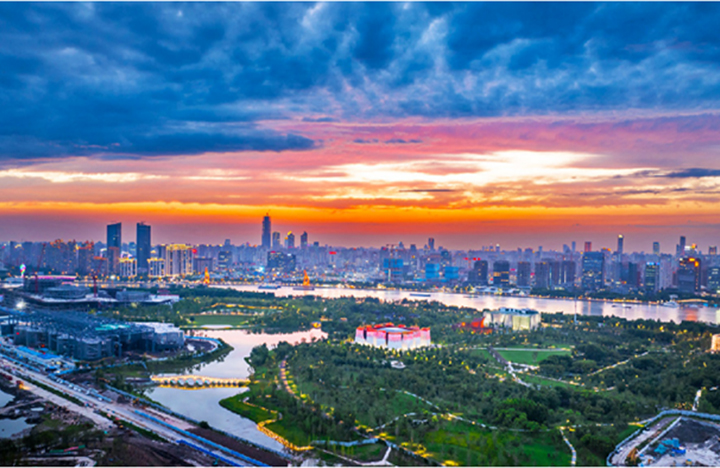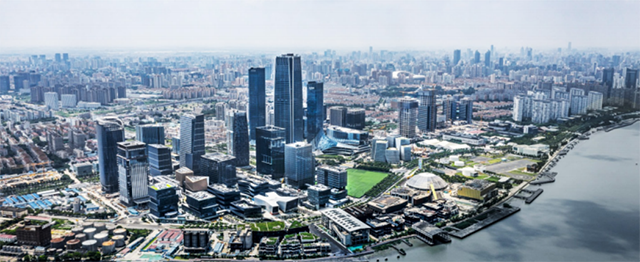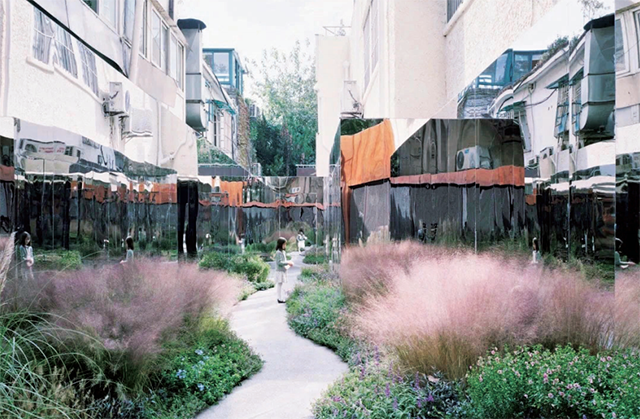


Urban renewal is an important means to transform the development mode of cities and promote high-quality urban development. Shanghai attaches great importance to urban renewal work. Under the guidance of the Ministry of Housing and Urban-Rural Development, Shanghai adheres to the concept of ‘Good households forms Good neighbourhoods, Good neighbourhoods makes Good communities, Good Communities creates Good urban areas.' It comprehensively promotes urban renewal, exploring sustainable development models to better support high-quality development, high-standard living, and highly efficient governance.

Pudong EXPO Park. [Photo/Architectural magazine]
As a mega-city that has experienced rapid development in the past century, Shanghai boasts a large population, a substantial stock of buildings, and inadequate living conditions. During the first phase, urban renewal efforts primarily focused on alleviating housing problems and urban development, with the transformation of old areas being the main form and driving force. By July 2022, the comprehensive renovation of densely populated substandard housing areas in the central urban area, which had been ongoing for 30 years, was successfully concluded. Approximately 40.7 million square meters of housing renovation were completed, significantly improving the living conditions for around 1.65 million households and 5 million residents. Moreover, these efforts played a crucial role in enhancing Shanghai's urban functions, adjusting the spatial structure, promoting the economic growth, protecting the environment, and preserving the aesthetics landscape.
To further implement the concept of the people's city and improve citizens' living conditions, Shanghai established a specialized task force for the renovation of "Renewing the Old, Reforming the (urban) Village" in September 2022. This initiative aims to accelerate the comprehensive renovation of sporadic old housing, small beam-thin board housing, and urban villages (referred to as "RORV" renovation), demonstrating a firm commitment to completing this renovation within two government terms over a span of 10 years and in three phases. The plan includes completing the renovation of scattered substandard housing in the central urban area by 2025, renovating structurally unstable housing and dilapidated areas in the edge of the city center by 2027, and completing the renovation of incomplete workers' housing and urban villages by 2032. Through these efforts, the city aims to enhance the sense of achievement, happiness, and security for its residents, ensuring a more substantial, secure, and sustainable living environment.
To effectively advance urban renewal efforts, Shanghai emphasizes the consolidation of the legal foundation and comprehensive systematic promotion. In 2021, the Standing Committee of the Shanghai Municipal People's Congress voted to pass the "Shanghai Urban Renewal Regulations." These regulations adhere to the principles of "retention, renovation, and regeneration" and prioritize preservation and protection. They follow the workflow of ‘Planning led, Society Coordinated, Government Promoted, Market Operated, Digital Empowered’, introduces principles like green low-carbon initiatives, and prioritizing people's livelihoods, as well as modes of co-construction and co-living. At the local legislative level, these regulations promote institutional innovation, providing strong legal safeguards for the construction of liveable, green, resilient, smart, and humanistic cities.
Simultaneously, Shanghai has developed urban renewal action plans. These plans focus on six key actions, including comprehensive regional revitalization, improvement of living environment quality, optimization of public space facilities, reshaping of historical charm, upgrading industrial parks, and revitalizing commercial vitality. By accelerating the progress of key projects, Shanghai aims to establish sustainable and replicable renewal models, allowing residents to witness changes and share in the achievements.

Xuhui Waterfront. [Photo/Architectural magazine]
In implementing the comprehensive regional revitalization action, a work process has been established to build a path for regional renewal projects, comprising the stages of "Renewal Action Plan—Coordination Entity Determination—Formulation of Renewal Plans—Implementation of Urban Renewal." Currently, regional renewal projects such as the "Second Facade" of the Huangpu Bund, North Bund renovation, Baoshan-Wusong Innovation City, and the core area construction of the Hongqiao International Central Business District are progressing in an orderly manner.
In the implementation of the action to improve living environment quality, the principle of "Visiting the households, Echoing with the Dwellers, Addressing their Concerns, and Warming their Hearts" is upheld. Continual improvement of mechanisms for public participation is pursued, with accelerated progress in the renovation of "RORV". Innovative approaches have emerged in various areas: "Eight Methods of Renovating Old Houses" have been developed in Fanggua Alley, Jing'an District; Ruikangli in Hongkou District has explored new models of renovation and transformation of old residential neighborhoods and new mechanisms for financial balance; projects such as Pudong's Panlong Village and Minhang's Zhaolou Village have effectively preserved historical contexts and further enhanced regional environmental quality. Efforts are being intensified to accelerate the construction of beautiful neighbourhoods, enhance residential and living quality, actively build and secure affordable rental housing, and establish the "Home for Urban Constructors and Managers in the New Era," focusing on addressing the housing needs of frontline urban construction and operation personnel such as migrant construction workers.
In the implementation of the action to optimize public space facilities, efforts are accelerated to fill gaps in public services by carrying out infrastructure upgrades and building energy-saving renovations. The development, construction, and management of the "Flowing with the Huangpu River and Suzhou River" are coordinated, with continuous efforts to enhance the connectivity and functional quality of waterfront public spaces, aiming to create a new pattern for world-class waterfront areas. Initiatives such as the "Park+" and "+Park" are promoted to meet the diverse needs of citizens, with a focus on integrating parks with various functions such as sports, culture, and tourism, promoting comprehensive openness, integration, and enhancement of parks and the city. High-quality beautiful street block construction is undertaken, extending to back alleys and lanes, creating a series of popular "Netizen Must-GO" spots for citizens.
In the action to reshape the charm of historical heritage, strict protection and management are ensured during the renovation process. Suitable uses for historical heritage buildings are explored to promote the revitalization of historical and cultural resources. Renovation of representative buildings such as the Reformed College of The Lester Sch.&Henry Lester Institute of Technical Education in Hongkou, the Wukang Building in Xuhui, Zhang Garden in Jing'an, and the Hero Pen Factory in Taopu, Putuo, have been completed. Continuous exploration of urban renewal work in areas with historical contexts is ongoing, such as the historical and cultural district of West Gate in Jiading and Nanchiao Yuan in Fengxian.
In implementing the action to enhance the quality and efficiency of industrial parks, efforts are made to accelerate the upgrading of key industrial agglomeration areas in line with the modernization of Shanghai's industrial system and the development needs of the "Made in Shanghai" brand. This involves upgrading the positioning of industrial parks and optimizing infrastructure. Projects such as the Yangpu Internet Innovation Zone and the Minhang Lipobo Brewery have achieved industrial upgrading while effectively preserving the historical charm of industrial buildings. Additionally, distinctive open public spaces are created to seamlessly connect work and living areas.
In the action to rejuvenate commercial and business vitality, efforts are accelerated to promote the transformation and upgrading of traditional business districts and the renovation or transformation of commercial buildings. For example, the Shangshi·Xinso project in Changning combines commercial property management with the preservation of historic buildings, completing the transition from ancient architecture to modern urban cultural spaces. Innovative districts like Yuyuan Road in Changning optimize traditional commercial formats into experiential formats. Projects like Jing'an Wansheng Heaven and Earth seamlessly integrate public green spaces with commercial spaces to create multifunctional environments. Hotels such as Jing'an Jincang Wenhua Grand Hotel are transformed into Jincang Wenhua Square, achieving structural expansion and functional enhancement through the renovation and upgrading of commercial buildings.

Renovation of Xinhua Road Pocket Park in Changning District. [Photo/Architectural magazine]
Shanghai consistently regards urban renewal as a crucial lever for implementing urban master plans, driving urban transformation, and enhancing urban quality. Continuously refining work plans and innovating work mechanisms, Shanghai explores establishing more sustainable urban renewal models. In 2023, in accordance with the central and municipal directives on studying and implementing Xi Jinping Thought on Socialism with Chinese Characteristics for a New Era, Shanghai actively explores new paths for sustainable urban renewal. Firstly, it adheres to comprehensive process optimization and comprehensive support, with urban master plans guiding urban renewal. By scientifically formulating renewal plans, comprehensively strengthening cost control, enhancing resource coordination, and promoting the application of advanced concepts, policy empowerment mobilizes various entities, enabling precise classification and implementation of urban renewal.
Secondly, it upholds professional and technical support, further leveraging the professional role of expert committees and piloting a system of "Three Professionals in Charge" (planning, architecture, and surveying). Leveraging platforms such as "one-stop" and "integrated management," a unified urban renewal information system is established to promote the development of urban renewal towards greater synergy, rapid feedback, low cost, high quality, and refinement, providing comprehensive support throughout the entire process of urban renewal.
The 20th National Congress of the Party requires adhering to the principle of cities built by the people and for the pople, improving urban planning, construction, and governance, accelerating the transformation of development modes for super and mega cities, implementing urban renewal actions, strengthening urban infrastructure construction, and creating livable, resilient, and smart cities. In response to new journeys and new demands, 2023 marks the commencement year for Shanghai's comprehensive promotion and implementation of urban renewal actions. Guided by Xi Jinping Thought on Socialism with Chinese Characteristics for a New Era and the spirit of the 20th National Congress of the Party, Shanghai will deepen the practice of the people's city concept, further strengthen systematic thinking, adhere to the principle of placing people at the center, reinforce the "four major functions," and construct the "five centers." It will grasp regional balance, comprehensive balance, and dynamic balance, coordinate the construction and operation of urban renewal projects, strengthen organizational support, improve mechanisms, enrich policy tools, enhance digital empowerment, and spare no effort in advancing the significant task of urban renewal to achieve sustainable development.
Source:<https://www.planning.org.cn/news/view?id=15337>
Translated by Xiong Yuxi